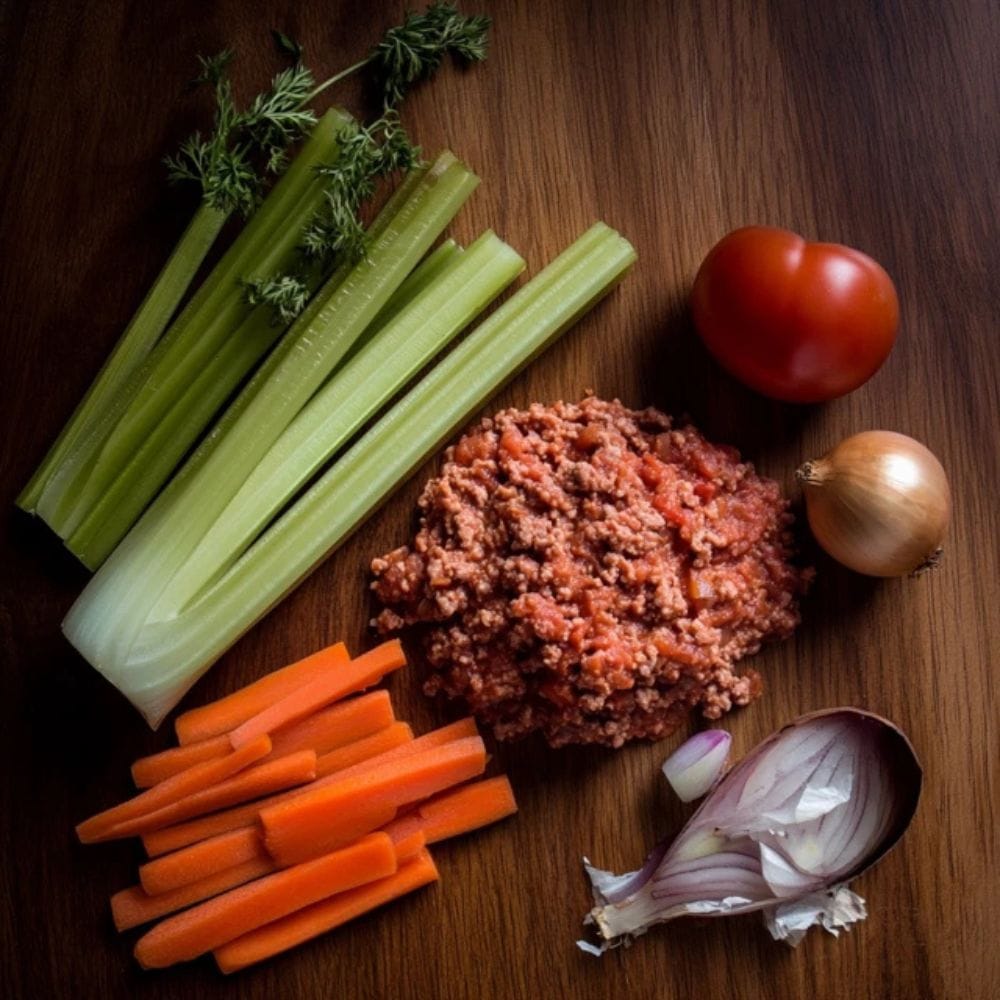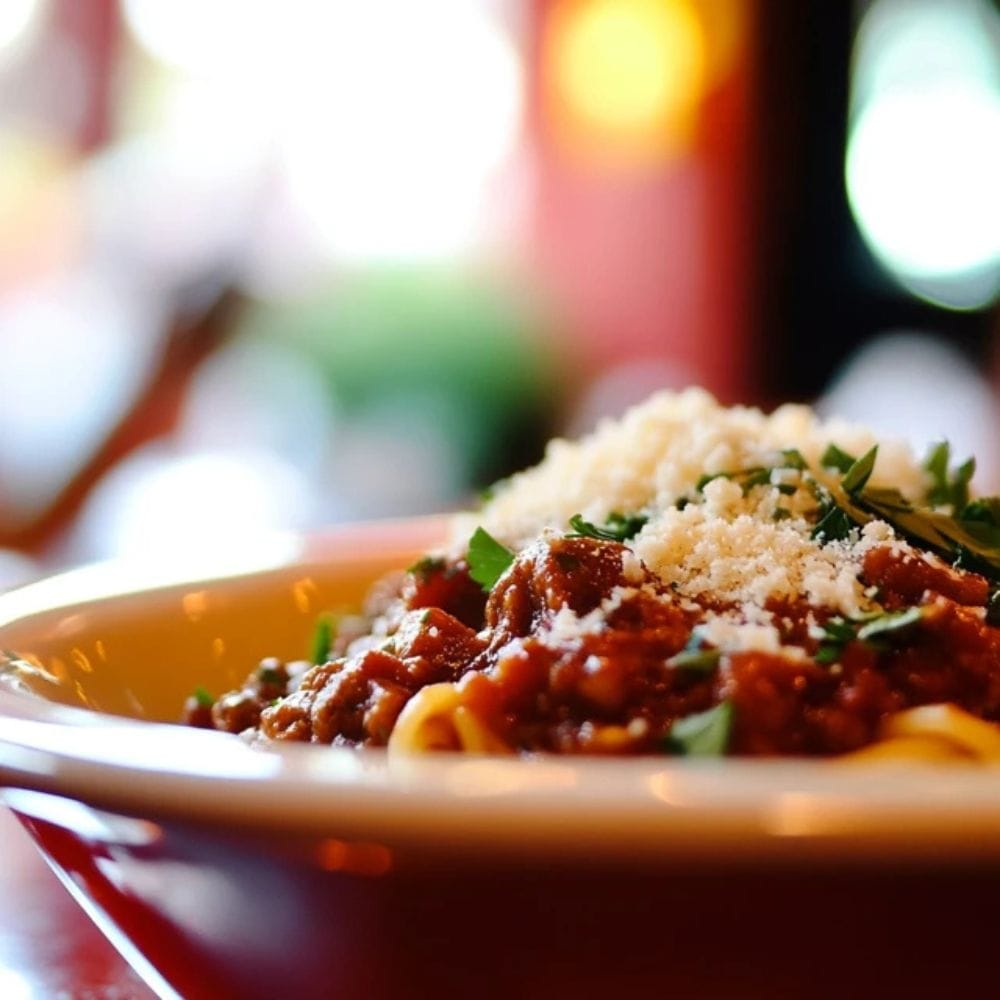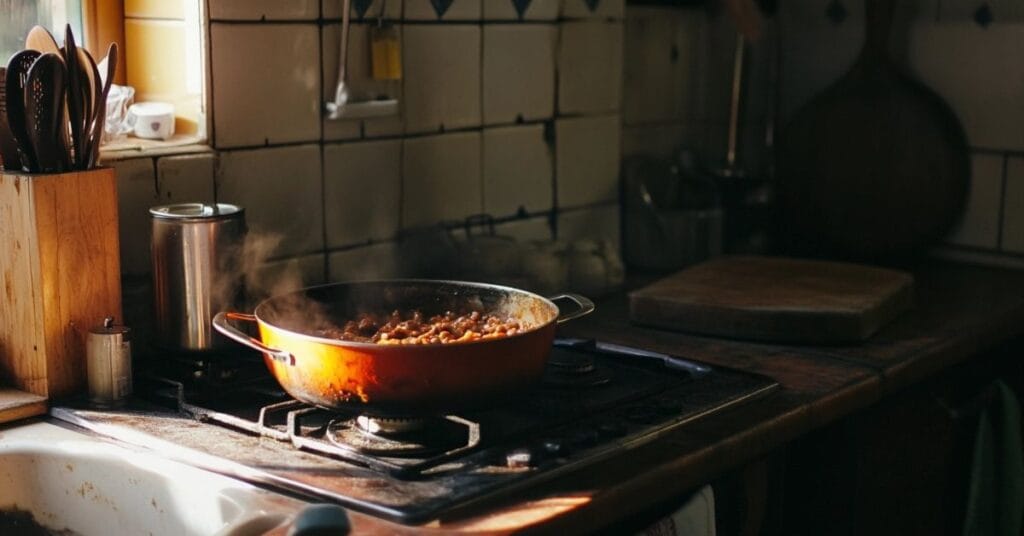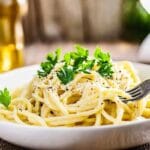Ragù, a beloved cornerstone of Italian cuisine, is elevated to a new level by the renowned chef Gordon Ramsay. His meticulous approach combines traditional techniques with modern flair, making his ragù recipe a must-try for anyone passionate about Italian cooking. If you’ve ever wondered, how does Gordon Ramsay make ragù, this guide unpacks the secrets behind his flavorful, slow-cooked masterpiece. From the finest ingredients to signature techniques, Ramsay’s method showcases why he’s considered a culinary legend.
The Essence of Ragù in Italian Cuisine
Traditional Components of Ragù
At the heart of Italian cuisine, ragù represents a slow-cooked, deeply flavorful sauce that has been perfected over generations. The dish relies on a careful balance of ingredients, each contributing to its rich, complex taste.
- Ground Beef & Pork – Provides depth of flavor, balancing lean and fatty textures.
- Mirepoix (Onions, Carrots, Celery) – A finely chopped aromatic base that lends sweetness and depth.
- Tomatoes (Fresh or High-Quality Canned) – Essential for tangy acidity, bringing balance to the dish.
- Wine or Broth – Adds layers of sweetness and richness, enhancing the umami profile.
Slow cooking is non-negotiable in traditional ragù—the sauce must simmer gently for hours, allowing the flavors to meld harmoniously. The result is a sauce that pairs beautifully with pasta, lasagna, polenta, or even crusty bread, showcasing its versatility in Italian cooking.
Regional Variations Across Italy
Italy’s diverse culinary heritage has led to multiple interpretations of ragù, each unique to its region.
- Ragù alla Bolognese (Bologna) – Incorporates milk or cream, creating a rich, velvety texture.
- Ragù Napoletano (Naples) – Features chunks of slow-cooked meat rather than ground beef, offering a more robust bite.
- Calabrian Ragù (Calabria) – Introduces spicy elements, such as sausage and red chili flakes, for a bolder flavor profile.
Despite these variations, one principle remains universal: patience is key. A slow simmer allows the ingredients to develop their full potential, making ragù one of Italy’s most treasured culinary traditions.
✔ Modern chefs, including Gordon Ramsay, have reinterpreted ragù, staying true to its roots while adding personal flair.
Gordon Ramsay’s Interpretation of Ragù
How Does Gordon Ramsay Make Ragù?
Gordon Ramsay’s ragù recipe showcases his culinary expertise in layering flavors. His approach respects tradition while enhancing depth and texture through precise techniques.
Key Steps in Ramsay’s Ragù:
✔ Sautéing the Mirepoix – Onions, carrots, and celery are cooked until caramelized, unlocking their natural sweetness.
✔ Browning the Meat – A mix of ground beef and pork is seared to develop a golden crust, intensifying umami richness.
✔ Deglazing with Red Wine – Scraping up browned bits enhances the complexity and depth of the sauce.
✔ Using San Marzano Tomatoes – These low-acid, naturally sweet tomatoes create a balanced, vibrant base.
✔ Incorporating Fresh Herbs – Thyme and rosemary add aromatic depth, elevating the sauce’s fragrance.
✔ Simmering for Hours – Gentle heat allows all ingredients to harmonize, creating a silky, flavorful sauce.
Signature Twists in Gordon Ramsay’s Ragù
What makes Ramsay’s ragù unique is his ability to refine classic techniques with thoughtful additions.
✔ Balsamic Vinegar – Introduces a subtle sweetness and acidity, deepening the sauce’s flavor profile.
✔ Nutmeg – A surprising yet subtle spice that adds warmth and depth.
✔ Butter Instead of Milk – Unlike traditional Bolognese, Ramsay opts for butter to achieve a luxurious texture.
These small but impactful changes showcase Ramsay’s ability to modernize a classic without compromising authenticity. His ragù remains timeless and deeply flavorful, proving that tradition and innovation can coexist beautifully in the world of Italian cuisine.

Selecting the Best Ingredients for Ragù
Choosing Quality Meats
The meat selection is crucial in Gordon Ramsay’s ragù, as it directly impacts flavor, texture, and richness. Ramsay recommends a blend of freshly ground beef and pork, ensuring the right balance of lean meat and fat for a deep, well-rounded taste.
✔ Ground Beef & Pork Mix – Provides richness and tenderness.
✔ Pancetta or Guanciale – Adds a savory, smoky depth to the sauce.
✔ Higher Fat Content = More Flavor – Fat renders into the sauce, enhancing its silkiness and taste.
Where to source quality meat:
- Buy from trusted butchers or premium markets that guarantee freshness.
- Opt for meat with visible marbling for a juicier, more flavorful sauce.
⚠ Avoid extra-lean meats—they lack the essential fat needed for an authentic ragù.
Best Tomatoes for Sauce-Making
Tomatoes form the foundation of a great ragù, providing acidity, sweetness, and richness. Gordon Ramsay prefers San Marzano tomatoes, known for their natural sweetness and smooth consistency.
✔ San Marzano Tomatoes – Low acidity, sweet, rich, and balanced.
✔ Whole Canned Tomatoes – Hand-crushed for a rustic, textured sauce.
✔ Avoid overly processed tomato products – They may contain too much acidity or added preservatives.
⚠ If fresh tomatoes aren’t available, high-quality canned San Marzano tomatoes are the next best option.
Step-by-Step Guide: How Does Gordon Ramsay Make Ragù?
Preparing the Mirepoix
Ramsay’s ragù starts with a perfectly prepared mirepoix—a classic combination of:
✔ Onions – Adds natural sweetness and depth.
✔ Carrots – Balances acidity from the tomatoes.
✔ Celery – Contributes an earthy undertone.
How to properly sauté the mirepoix:
- Heat olive oil in a heavy-bottomed pan.
- Gradually add the vegetables, stirring frequently to ensure even cooking.
- Allow the mixture to caramelize slightly—this releases natural sweetness and intensifies depth.
✔ Pro Tip: Finely chop the vegetables for a smooth, well-integrated sauce.
⚠ Avoid rushing this step—a properly caramelized mirepoix lays the foundation for a deeply flavorful ragù.
Browning the Meat
After preparing the mirepoix, Ramsay browns the meat thoroughly, which is essential for flavor development.
Why browning is crucial:
✔ Caramelization enhances umami richness.
✔ Rendering fat creates a velvety sauce texture.
✔ Prevents a “boiled” texture by allowing proper searing.
How to brown meat properly:
- Add ground beef and pork to the pan with the mirepoix.
- Stir occasionally, breaking apart the meat to avoid clumping.
- Let it develop a golden-brown crust—this step intensifies flavor.
- Avoid overcrowding—too much meat in the pan leads to steaming instead of searing.
✔ Pro Tip: Drain excess grease if necessary, but leave enough to retain richness.
⚠ Skipping this step results in a bland, one-dimensional sauce.
Deglazing and Simmering
Deglazing unlocks extra layers of depth in Ramsay’s ragù. This step incorporates the rich browned bits from the pan into the sauce, ensuring maximum umami flavor.
✔ Ramsay’s choice: Red wine (Chianti or Merlot) – Adds depth without overpowering the dish.
Key Steps for Deglazing:
- Pour red wine into the pan, scraping up browned bits with a wooden spoon.
- Allow wine to reduce by half, concentrating its flavors.
- Stir in hand-crushed San Marzano tomatoes.
Once combined, the sauce must simmer gently—this slow cooking method marries all the flavors together.
✔ Best Simmering Tips:
✔ Use low heat to allow flavors to blend naturally.
✔ Partially cover the pan to control moisture loss.
✔ Stir occasionally to prevent sticking and ensure even cooking.
Key Tips for Deglazing and Simmering
✔ Use a sturdy wooden spoon to scrape up caramelized bits.
✔ Reduce wine by half before adding tomatoes to prevent excessive acidity.
✔ Simmer for at least an hour—longer cooking results in a richer, silkier sauce.
By following these steps, you can replicate Gordon Ramsay’s signature ragù, achieving restaurant-quality depth and texture at home.
Enhancing Ragù with Wine
Selecting the Appropriate Wine
Choosing the right wine is another vital element in how Gordon Ramsay makes ragù. A full-bodied red wine works best, complementing the meat’s richness and balancing the tomatoes’ acidity. Ramsay often opts for Italian wines like Sangiovese or Barbera, as they bring an earthy quality that harmonizes with the sauce’s robust character.
Avoid wines labeled as “cooking wine,” as they often lack the depth needed for a quality ragù. If wine isn’t an option, beef or vegetable broth can be a suitable alternative, although it may alter the sauce’s complexity slightly. The choice of wine underscores Ramsay’s philosophy that every ingredient contributes significantly to the final dish.
The Role of Wine in Flavor Development
Wine does more than add a rich, tangy note to the sauce—it enhances the ragù’s complexity by integrating acidity and subtle sweetness. The alcohol evaporates during cooking, leaving behind concentrated flavors. Ramsay’s technique involves adding the wine at just the right moment, ensuring it blends seamlessly into the sauce.
Moreover, the wine interacts with the fat from the meat, creating a smoother texture and boosting umami. This harmonious balance of acidity, sweetness, and richness is one of the defining characteristics of Ramsay’s ragù. For those seeking the perfect wine pairing, check out this guide on the best wines for cooking.
Seasoning and Flavor Balance in Gordon Ramsay’s Ragù
Use of Herbs and Spices
Herbs and spices play a vital role in defining the depth and complexity of Gordon Ramsay’s ragù. His go-to selections enhance aroma, warmth, and balance in the sauce.
✔ Fresh Thyme & Rosemary – Adds earthy, aromatic depth without overpowering.
✔ Bay Leaves – Infuses a subtle bitterness that balances sweetness.
✔ Garlic – Used sparingly to add warmth without overwhelming the dish.
✔ Black Pepper & Chili Flakes – Provides gentle heat and complexity.
Ramsay’s Key Seasoning Strategy:
✔ Salt in stages rather than all at once to maintain flavor balance as the sauce reduces.
✔ Taste regularly to adjust seasoning throughout the cooking process.
Achieving the Perfect Flavor Profile
Ramsay’s ragù strikes the perfect balance between acidity, sweetness, and umami.
✔ Pinch of Sugar – Neutralizes excessive tomato acidity.
✔ Balsamic Vinegar – Enhances sweetness while adding a slight tang.
✔ Slow Simmering – Allows ingredients to meld into a smooth, cohesive sauce.
Flavor-Balancing Tips:
✔ Taste frequently during cooking to fine-tune seasonings.
✔ Adjust salt and sugar in small increments for precision.
✔ Add fresh herbs toward the end to preserve their brightness.
Cooking Techniques: How Does Gordon Ramsay Make Ragù?
Slow Cooking for Depth of Flavor
The hallmark of Ramsay’s ragù is slow cooking, which allows flavors to develop fully and the sauce to reach its ideal consistency.
✔ Minimum simmering time: Two hours – Essential for tender meat and rich depth.
✔ Low, steady heat – Prevents overcooking or burning.
✔ Regular stirring – Ensures even distribution of heat and flavors.
Why Slow Cooking Matters:
✔ Breaks down tough fibers in the meat, making it incredibly tender.
✔ Encourages a gradual melding of ingredients, resulting in a complex, layered sauce.
✔ Thickens naturally without relying on additional thickeners.
Importance of Stirring and Monitoring
Consistent stirring maintains the sauce’s texture and prevents burning. Ramsay emphasizes proper monitoring to ensure even cooking.
✔ Use a heavy-bottomed pot – Retains heat evenly and prevents scorching.
✔ Stir every 15-20 minutes – Distributes heat and avoids sticking.
✔ Adjust liquid levels if needed – If sauce thickens too much, add a splash of water or broth.
Key Cooking Tips:
✔ Use a wooden spoon to prevent scratching the pot and to lift caramelized bits.
✔ Maintain low heat for a gradual, controlled simmer.
✔ Allow time for flavors to intensify—patience leads to a rich, deeply satisfying ragù.
By following Ramsay’s techniques and attention to detail, you can create a restaurant-quality ragù that embodies flavor, texture, and balance in every bite.
Serving Suggestions for Gordon Ramsay’s Ragù

Pairing Pasta with Gordon Ramsay’s Ragù
The choice of pasta significantly impacts the final dish, as different shapes interact with the sauce in unique ways. Gordon Ramsay pairs his rich ragù with pasta that complements its depth and texture.
✔ Tagliatelle or Pappardelle – Wide, flat surfaces hold the sauce beautifully.
✔ Rigatoni or Penne – Their ridged exteriors capture every bit of the ragù.
✔ Ditalini (for a unique twist) – Though commonly found in soups, ditalini offers a delightful texture that works well with ragù.
✔ Ramsay’s Technique:
- Cook pasta al dente – Ensures the perfect bite.
- Toss pasta directly into the sauce for the final minute – Allows flavors to fully integrate.
- Serve immediately for the best texture and taste.
Want to explore more pasta options?
Check out Recipes Nerd’s guide on ditalini pasta and their insights on the best pasta for ragù.
Garnishing and Presentation
Presentation enhances the appeal of Ramsay’s ragù, making it visually inviting and flavorful.
✔ Freshly Grated Parmesan – Adds a savory, nutty depth.
✔ Chopped Parsley – Provides a fresh contrast to the rich sauce.
✔ A Drizzle of High-Quality Olive Oil – Enhances silkiness and flavor complexity.
✔ Warm Serving Dishes – Keeps the ragù at the ideal temperature for serving.
✔ For an extra touch:
- Serve with crusty Italian bread to soak up every last bit of the sauce.
- Pair with a robust red wine, such as Chianti or Barolo, to complement the ragù’s depth.
By paying attention to pasta pairing, garnishing, and presentation, you can bring Ramsay’s signature ragù to life in a way that’s both authentic and elegant.
Nutritional Profile of Traditional Ragù
Macronutrient Breakdown
Gordon Ramsay’s ragù strikes a balance between indulgence and nourishment, offering a mix of protein, healthy fats, and fiber.
✔ Protein Source – The ground beef and pork provide a robust protein content essential for muscle health.
✔ Healthy Fats – Fat from meat and olive oil enhances flavor and satiety.
✔ Fiber & Nutrients – The mirepoix (onions, carrots, celery) contributes fiber and micronutrients.
✔ For a lighter version:
- Use leaner cuts of meat to reduce saturated fat.
- Limit added butter or oil while maintaining flavor depth.
Vitamins and Minerals
Beyond macronutrients, ragù is a powerhouse of essential vitamins and minerals.
✔ Tomatoes (Vitamin C & Antioxidants) – Supports immune health and fights free radicals.
✔ Carrots (Beta-Carotene & Vitamin A) – Promotes good vision and skin health.
✔ Celery & Onions (Potassium & Flavonoids) – Aids in heart health and digestion.
Ramsay’s ingredient choices ensure that his ragù isn’t just flavorful—it’s also deeply nourishing.
Common Mistakes to Avoid When Making Ragù
Overlooking Ingredient Quality
Using subpar ingredients can significantly affect the final taste of ragù. Ramsay insists on:
✔ High-quality meat – Ensures rich, deep flavors.
✔ Premium tomatoes – Avoids excess acidity or artificial additives.
✔ Fresh herbs & aromatics – Enhances authentic Italian depth.
⚠ Skipping quality ingredients may save time, but it weakens the dish’s complexity.
Rushing the Cooking Process
A key misstep is rushing the essential steps of making ragù.
✔ Browning the meat properly – Develops umami and texture.
✔ Slow simmering the sauce – Allows flavors to fully integrate.
✔ Layering flavors with patience – Ensures a rich, well-rounded sauce.
⚠ Cooking on high heat or skipping deglazing results in a harsh, underdeveloped sauce.
Common Ragù Mistakes & How to Avoid Them
| Mistake | Why It’s a Problem | Solution |
|---|---|---|
| Using low-quality ingredients | Weakens overall flavor | Invest in fresh, high-quality produce and meats |
| Cooking on high heat | Can cause burning and bitterness | Maintain a gentle simmer for depth |
| Skipping deglazing | Misses out on layered umami flavors | Always deglaze with wine or broth after browning meat |
| Not stirring regularly | Can lead to sticking and uneven cooking | Stir every 15-20 minutes |
By avoiding these mistakes and following Ramsay’s techniques, home cooks can achieve restaurant-quality ragù every time.
FAQs About How Gordon Ramsay Makes Ragù
What Meats Does Gordon Ramsay Use in His Ragù?
Gordon Ramsay’s ragù typically combines ground beef and pork, offering a perfect balance of flavor and texture. He occasionally adds pancetta for a smoky undertone. These meats provide the richness and depth that make the ragù exceptional.
If you’re looking for substitutions, veal or even turkey can work, though they may alter the traditional taste. Ramsay emphasizes choosing high-quality, fresh meats to replicate the authentic flavors of his recipe.
Does Gordon Ramsay Include Wine in His Ragù Recipe?
Yes, Ramsay incorporates red wine as a key ingredient in his ragù. The wine deglazes the pan after browning the meat, adding depth and complexity to the sauce. He recommends using full-bodied wines like Chianti or Merlot, as they complement the tomatoes and meat without overpowering the dish.
For those avoiding alcohol, a robust beef or vegetable broth can substitute the wine, though it won’t replicate the exact flavor profile Ramsay achieves.
How Long Does Gordon Ramsay Recommend Simmering the Ragù?
When considering how Gordon Ramsay makes ragù, simmering time is crucial. Ramsay advises letting the sauce simmer gently for at least two hours. This slow cooking allows the flavors to meld and deepen while tenderizing the meat and thickening the sauce to the perfect consistency.
Stir occasionally and monitor the heat to avoid burning. If the sauce becomes too thick, adding a splash of water or broth can help maintain the desired texture.
What Type of Pasta Pairs Best with Gordon Ramsay’s Ragù?
Gordon Ramsay’s ragù pairs beautifully with hearty pasta types that can hold up to the thick, robust sauce. He frequently uses tagliatelle or pappardelle, whose wide ribbons capture the ragù’s flavors effectively. Penne or rigatoni also work well, thanks to their ridged surfaces.
For an authentic experience, toss the pasta in the sauce just before serving. This technique ensures every strand is coated, enhancing the dish’s flavor and texture.
Can Gordon Ramsay’s Ragù Be Made in Advance and Reheated?
Absolutely! Ramsay’s ragù is even better when made in advance, as the flavors continue to develop over time. Store it in an airtight container in the refrigerator for up to three days, or freeze it for longer storage. Reheat gently on the stove, adding a splash of water or broth if the sauce has thickened.
This make-ahead quality makes how Gordon Ramsay makes ragù not only delicious but also convenient for meal planning or entertaining.
Final Thoughts on Gordon Ramsay’s Ragù
Gordon Ramsay’s ragù is a masterful blend of tradition and innovation, showcasing his culinary expertise. By focusing on quality ingredients, precise techniques, and patient cooking, he transforms a classic Italian dish into a work of art. Each step in the process—from preparing the mirepoix to selecting the perfect wine—demonstrates his dedication to flavor and authenticity.
Trying this recipe at home offers a rewarding experience. Whether serving it with tagliatelle or using it in a hearty lasagna, Ramsay’s ragù elevates any meal. Follow his techniques, avoid common mistakes, and embrace the art of slow cooking to achieve restaurant-quality results.
Now it’s your turn to master the secrets behind how Gordon Ramsay makes ragù. Gather your ingredients, set aside time, and savor the rich, satisfying flavors of this iconic dish.






